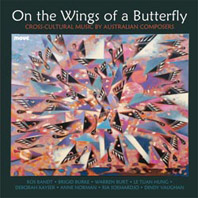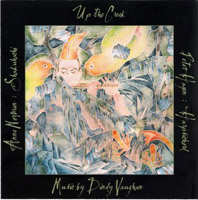 |
MD3297
www.move.com.au/
 |
www.crackedrecords.com.au
The influence of New Age-ism, and its associated, banal reinterpretations of Brian Eno’s “ambient music”, has contributed to a surfeit of dubious, cross-cultural musics.
Machine For Making Sense react against this by crafting harsh textures and violent, sound art concatenations (for example, Dissect the Body, featuring Satsuki Odamura on koto and Stevie Wishart on hurdy-gurdy), while Liza Lim and Julian Yu produce orchestral works incorporating European and Oriental instrumentation which possess some characteristics of both Euro-American Romanticism and high modernist dissonance and atonalism. The material compiled by editor/producer Le Tuan Hung for On the Wings of a Butterfly has some sympathy with this second approach—notably Brigid Burke’s fabulous, lightly perturbed mix of scattered percussion, sudden tabla accents, and irregular rumblings of clarinet, embedded within a harmonic vibraphone and electronics wash (track seven). On the whole however the artists presented here have chosen less arch and more lyrical methods, with several Oriental classical traditions being brought together with European Medieval and Renaissance ideas as well as atmospheric percussion. In this sense, On the Wings of a Butterfly sits well alongside the rest of the work of soprano Deborah Kayser (featured here in collaboration with shakuhachi player Anne Norman), Jouissance and others. While not “wallpaper music” in Eno’s sense, On the Wings of a Butterfly largely presents a meditative, seductive listening experience whose aggressive elements are found more in sudden jumps of the volume (as with Dindy Vaughan’s work; tracks five to six), rather than in overt sonic or textural distinctions. The materials are on the whole well balanced, harmonised and successfully melded. The approach is therefore more one of fusion rather than contrast or dialectic, of finding common timbre and rhythmic patterns across traditions rather than setting them against each other in a kind of debate.
On the first track, Kayser and Norman present a gorgeous, soaring, while at times barely breathed meditation on the work of Hildegard von Bingen, the long, gliding tones of the shakuhachi complementing the extended vocal lines of early European liturgical chorale. This is perhaps not surprising given that both musics developed partly to assist spiritual contemplation.
Nevertheless, some of the shorter, more hesitant enunciations of the duo help to give their interpretation a more modern, formalist touch. Norman’s collaboration with vocalist Ria Soemardjo (track three), underscored by Hindustani dulcimer strings, successfully melds two Oriental improvisatory traditions (Japanese and Indian) in a work which not only recalls the ragas and chants of the Indian subcontinent, but also incorporates some freer, non-verbal sung motifs, which are, in turn, echoed by Norman. Tuan Hung’s own contributions, in which he plays dan tranh or Vietnamese zither, are less effective, with the musician tending to flatten the material by interjecting repeated passages of strumming rising and falling through whole scales (notably in his collaboration with Ros Bandt on Medieval psaltery; track two). Where Tuan Hung resists this particular temptation, on track four, his work is impressive, the zither’s slightly fractured, discordant tones and string-bending technique answered or supported by ringing bell percussion and open, tube-y sounding pan-pipes.The CD closes somewhat disappointingly with the linguistically unremarkable (and strikingly Orientalising) poetry of Rewi Alley (tracks eight to 11), supported by shifting organ chords from Warren Burt, to which the vocals have also been tuned.
On the Wings of a Butterfly features an additional two compositions selected from Vaughan’s own CD, Up the Creek. The latter, 12-track collection sees Norman paired with harpsichordist Peter Hagen. The duo play six works together, and then perform as soloists on three pieces each. Hagen’s technique is at times harsh and brutal, with Norman generally doubling the main harmonic lines and introducing sections with a rising, breathy spaciousness, or rising above the stately lines of the harpsichord to lead in a complicated series of jumps and glides. As noted earlier, the dynamic of the pieces is often striking, with abrupt leaps from quieter, building sequences and scattered phrases, versus loud, crashing motifs and crescendos.
The harpsichord is such a cultural loaded instrument that images of Baroque symmetry and early cinema horror soundtracks cannot help but intrude, with much of the interest being generated by how Vaughan disabuses one of such assumptions without totally abandoning the idea of adding her own little, mathematic, self-enclosed passages, derived in part from the high Classical tradition. While only occasionally exhibiting actual atonalism, several tracks nevertheless attain a dissonant complication of musical structure through the tentative indirectness of the links between passages as well as their attendant silences, which makes for a highly unconventional listening experience. The vaguely modernist tracks five and six break, clash and then pause in a highly arresting manner.
Norman’s solos move from clipped materials which sound almost like discontinuous allusions to Stravinsky’s Firebird played on shakuhachi, to the more characteristic woody, breathy tones of the instrument, but with a fluttering and lack of intensity only found in 20th century American-Japanese composition. Hagen has less to play with in this sense with his rather more unbending instrument—though during the duets he performs some arrested plucking of the strings and abortive, percussive keyboard strikes. The recordings also include a subdued background of feet rearranging and wooden finger-block clattering. Up the Creek is, in short, a very interesting collection of pieces which is worth repeated listening to fully appreciate its sometimes hidden intricacies. Overall, Up the Creek is somewhat more satisfying than On the Wings of a Butterfly, exhibiting in a more overt fashion a sense of musical and textural rigour in composition. Nevertheless, both are fine, thought-provoking additions to the ongoing corpus of approaches which bring together the various and only indistinctly separate terms of Oriental, Western, Euro-American, traditional, classical, Early Music and New Music.
Jonathan Marshall
© Jonathan Marshall; for permission to reproduce apply to [email protected]








 back
back